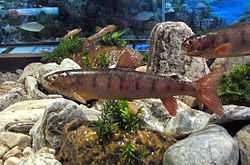Brachymystax tumensis
| Brachymystax tumensis | |
|---|---|
 | |
| Museum specimen | |
| Conservation status | |
| Not evaluated (IUCN 3.1) | |
| Scientific classification | |
| Kingdom: | Animalia |
| Phylum: | Chordata |
| Class: | Actinopterygii |
| Order: | Salmoniformes |
| Family: | Salmonidae |
| Subfamily: | Salmoninae |
| Genus: | Brachymystax |
| Species: | B. tumensis |
| Binomial name | |
| Brachymystax tumensis Mori, 1930[1] | |
Brachymystax tumensis, the blunt-snouted lenok,[2] is a salmonid fish distributed in rivers and lakes in Eastern Asia. It was formerly included in the more widespread species Brachymystax lenok (now known as the sharp-snouted lenok), but more recent research based on differences in morphology and genetics have justified a distinction of the two species.[2][3][4][5]
B. tumensis is found widely in southeastern Russia and more locally in northeastern and central parts of the country (including Sakhalin), as well as northeastern Mongolia (Amur Basin), northern China and Korea (e.g. Tumen River).[2][1] In some regions, such as the Amur Basin, the range may overlap with that of B. lenok.[2][3][5]
References
- ↑ 1.0 1.1 Froese, Rainer and Pauly, Daniel, eds. (2014). "Brachymystax tumensis" in FishBase. October 2014 version.
- ↑ 2.0 2.1 2.2 2.3 Kartavtseva, I.V.; Ginatulina, L.K.; Nemkova, G.A.; and Shedko, S.V. (2013). Chromosomal study of the lenoks, Brachymystax (Salmoniformes, Salmonidae) from the South of the Russian Far East. Journal of Species Research 2(1):91-98.
- ↑ 3.0 3.1 Bo, M. A.; and Jiang, Zuo-fa (2007). Genetic diversity and relationship between two species of Brachymystax in Wusuli River revealed by microsatellites. Journal of Fishery Sciences of China 14: 39-45.
- ↑ Balakirev, E.S.; Romanov, N.S.; and Ayala, F.J. (2014). Complete mitochondrial genome of blunt-snouted lenok Brachymystax tumensis (Salmoniformes, Salmonidae). Mitochondrial DNA 27: 1-2
- ↑ 5.0 5.1 Froufe, E.; Alekseyev, S.; Alexandrino, P.; and Weiss, S. (2008). The evolutionary history of sharp- and blunt-snouted lenok (Brachymystax lenok (Pallas, 1773)) and its implications for the paleo-hydrological history of Siberia. BMC Evolutionary Biology 8: 40.